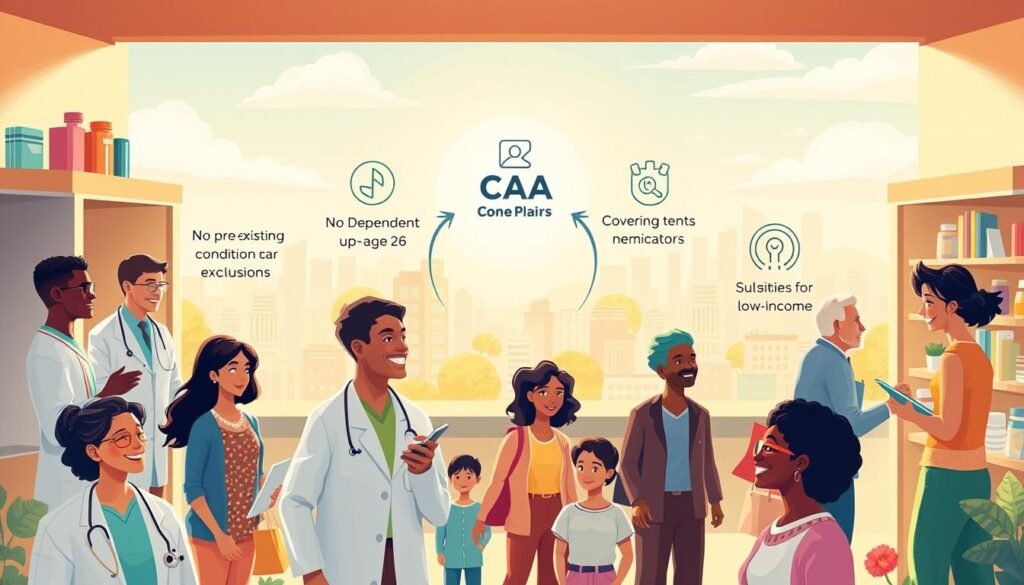
Affordable Health Coverage in the US
Navigating the world of health insurance ( can feel overwhelming, but it doesn’t have to be. My journey to finding the right plan taught me the importance of understanding the Health Insurance Marketplace and the protections offered by the Affordable Care Act. Whether you’re an individual, a family, or a small business owner, there are options tailored to your needs.
Eligibility for the Marketplace requires living in the U.S., being a citizen or lawfully present, and not being incarcerated. One of the most significant benefits of the ACA is that insurers cannot deny coverage based on pre-existing conditions or impose lifetime limits on essential benefits1. This ensures that everyone has access to the care they need.
In this guide, I’ll break down complex topics like premiums, deductibles, and out-of-pocket costs in simple terms. I’ll also share insights from my own research and experiences to help you make informed decisions. Understanding these details can make all the difference in finding a plan that works for you.
Key Takeaways
- Eligibility for the Health Insurance Marketplace requires U.S. residency and lawful presence.
- The Affordable Care Act protects against denial of coverage for pre-existing conditions.
- Premiums and deductibles vary by plan tier (Bronze, Silver, Gold, Platinum).
- Special enrollment periods may offer lower monthly premiums for eligible individuals.
- Small businesses can access health insurance options through the SHOP Marketplace.
Understanding the Health Insurance Marketplace
Finding the right plan starts with understanding the Health Insurance Marketplace. Created by the Affordable Care Act (ACA), the Marketplace is designed to help individuals and families access tailored insurance options. It’s a one-stop shop where you can compare plans, check eligibility, and find financial assistance2.
Marketplace Eligibility and Requirements
To use the Marketplace, you must live in the U.S. and be a citizen or lawfully present. There’s no income limit, making it accessible to a wide range of people. Life changes like moving, getting married, or having a baby can qualify you for a Special Enrollment Period3.
Most applicants qualify for financial help, such as premium tax credits. These credits lower your monthly payments based on your income and family size2. This makes it easier to find a plan that fits your budget.
Cost Breakdown and Premium Considerations
When choosing a plan, it’s important to understand the costs. Premiums are the monthly payments you make for coverage. Deductibles are what you pay before your insurance starts covering costs. Other fees include coinsurance and copayments.
Plans are divided into four tiers: Bronze, Silver, Gold, and Platinum. Each tier has different cost-sharing arrangements. For example, Silver plans may offer extra savings for those who qualify2.
Open Enrollment runs from November 1 to January 15. Enroll by December 15 for coverage starting January 13. Understanding these details helps you make an informed decision and get the coverage you need.
Exploring the Affordable Care Act and Its Benefits
The Affordable Care Act has transformed access to coverage for millions. It ensures that everyone, regardless of their health history, can get the protection they need. This law has made insurance more accessible and fair for all4.

Key Protections under the ACA
One of the most significant changes is the protection for pre-existing conditions. Insurers can no longer deny coverage based on your health history5. This means that if you’ve had a chronic illness or past medical issues, you’re still eligible for a plan.
Another key benefit is the absence of lifetime and annual limits on essential benefits. This ensures that you won’t run out of coverage when you need it most4. Additionally, young adults can stay on their family’s plan until they turn 26, providing continuity and peace of mind.
Essential Coverage and Out-of-Pocket Costs
The ACA also defines essential health benefits that all plans must cover. These include preventive services, prescription drugs, and mental health care5. This ensures that you’re getting comprehensive protection.
Out-of-pocket costs are also capped, making it easier to budget for medical expenses. For example, in 2022, the maximum out-of-pocket limit for an individual plan was $8,7006. This helps protect you from unexpected financial burdens.
Understanding these elements can change the way you access and manage your insurance. The ACA’s reforms are designed to make coverage more reliable and fair for everyone.
Affordable Health Care USA: My Journey to Finding Coverage
Understanding the enrollment process was a game-changer for me. It helped me navigate the complexities of the Health Insurance Marketplace and find a plan that fit my needs. Here’s how I did it.
My Research Process and Resources
I started by exploring trusted websites like Healthcare.gov. These platforms provided clear information on eligibility and plan options. I also used tools to compare premiums and benefits, which made the decision easier.
One key takeaway was that the Affordable Care Act ensures all plans cover essential services like preventive care and prescription drugs7. This gave me confidence that I’d get comprehensive coverage.
Enrollment Experiences and Personal Insights
Enrolling was straightforward, but I faced a few challenges. For example, understanding the difference between deductibles and out-of-pocket costs took some time. However, the process became smoother once I broke it down step by step.
I learned that acting quickly during special enrollment periods can save time and money. Life events like moving or having a baby can qualify you for these periods7.
Understanding Special Enrollment Periods
Special enrollment periods are crucial for those who miss the annual open enrollment. They allow you to sign up for a plan outside the usual timeframe. I discovered that qualifying events include marriage, job loss, or changes in household size7.
Here’s a quick summary of the steps I followed:
| Step | Action |
|---|---|
| 1 | Check eligibility for special enrollment. |
| 2 | Gather necessary documents (e.g., proof of life event). |
| 3 | Compare plans on the marketplace. |
| 4 | Submit your application within the deadline. |

By following these steps, I was able to secure the right coverage for my needs. My journey taught me that with the right resources and a bit of patience, anyone can navigate the system successfully.
Tips for Choosing and Managing My Health Plan
Choosing the right health plan can feel like a puzzle, but with the right approach, it becomes manageable. I’ve learned that comparing options and understanding costs are crucial steps in making an informed decision. Here’s how I navigated the process to find the best fit for my needs.

Comparing Plans and Coverage Options
When I started looking for a plan, I focused on understanding the different tiers available. The Health Insurance Marketplace offers Bronze, Silver, Gold, and Platinum plans, each with unique cost-sharing arrangements8. Bronze plans have lower premiums but higher deductibles, while Gold and Platinum plans offer more coverage with higher monthly costs8.
I also checked if the plan included essential benefits like preventive care, prescription drugs, and mental health services. All plans in the Marketplace must cover these 10 categories by law8. This ensured I’d get comprehensive protection.
Here’s a quick comparison of plan tiers:
| Plan Tier | Premium | Deductible |
|---|---|---|
| Bronze | Low | High |
| Silver | Moderate | Moderate |
| Gold | High | Low |
| Platinum | Highest | Lowest |
Maximizing Benefits and Minimizing Costs
To get the most out of my plan, I looked for ways to reduce out-of-pocket expenses. If you qualify for extra savings, you must choose a Silver plan to access cost-sharing reductions8. This can significantly lower your deductibles and copayments.
I also reviewed the network of providers to ensure my preferred doctors and hospitals were included. HMO plans require a primary care physician for referrals, while PPOs offer more flexibility but at a higher cost9.
Finally, I used tools on the Marketplace to estimate my total yearly costs, including premiums, deductibles, and copayments8. This helped me budget effectively and avoid surprises.
By taking these steps, I was able to find a plan that met my needs and kept costs manageable. Regular reviews and updates ensure my coverage stays aligned with my lifestyle and health requirements.
Conclusion
Securing the right insurance plan transformed my approach to managing my well-being. My journey taught me the importance of understanding the Affordable Care Act and its protections for patients with pre-existing conditions10. These safeguards ensure everyone has access to the coverage they need.
Choosing the right plan involves comparing options and understanding costs. I found that Silver plans often offer extra savings, making them a great option for many people11. It’s also crucial to review provider networks and out-of-pocket expenses to avoid surprises.
I encourage you to use this guide to navigate the enrollment process confidently. Whether you’re exploring the Marketplace or qualifying for special enrollment periods, informed decisions lead to better outcomes. Take the time to compare plans carefully and utilize available resources.
Remember, understanding your options is the first step toward securing the right coverage for your needs. With the right plan, you can focus on what truly matters—your well-being.